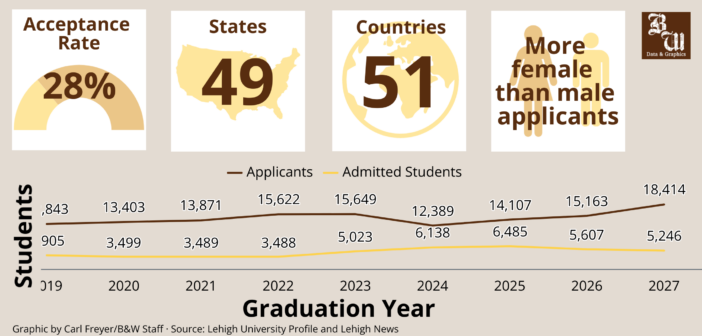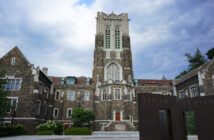Fewer students were admitted to Lehigh University for the third year in a row. The class of 2027’s acceptance rate is 28%. The rate has been steadily decreasing since the class of 2024’s spike of 49.5%.
This year’s applicant pool had 21% more applications compared to last year, with 18,414 total applicants for a targeted 1,500 spots in the incoming freshman class.
A total of 5,246 students were offered admission to Lehigh, which is about 300 fewer applicants than last year.
Around 51% of the class comprises the Early Decision I and II application round. The regular decision admissions will fill the rest of the class.
Increased Communication and Connection
Director of Admissions Bruce Bunnick said the Office of Admissions did not purposefully try to increase the number of applications received, but it was a product of the office broadening its communication to prospective applicants.
“We did have a more significant number of students that are in our prospect pool,” Bunnick said. “These are students that we communicate with and we market to. So that number increased, and we feel like in the long run it did have an impact on the total number of students who applied for admission.”
Brian Lucas, ‘23, served as a diversity admissions fellow in the office from summer 2021 to October 2022. He attributed a large increase in applications to the effort the office makes to make meaningful outreach.
He said the office has a proactive and responsive admissions team.
“They’re very on top of trying to connect with families,” Lucas said. “One of the biggest responsibilities we would have in the office, was to be a point of connection to the Admissions Office to help guide people through that process.”
Lucas said the number of people attending on-campus prospective student events has increased significantly the past three years as more people have the opportunity to visit colleges in person.
Bunnick said a common theme with this year’s applicant pool is resilience.
“This class entered high school under COVID restrictions and managed to come out on very positive footing,” Bunnick said. “They, like so many students, managed to weather the storm, learn from it, and still kept their eye on their own studies, their commitment to leadership, athletics and all the activities that they presented.”
Dan Warner, vice provost for admissions and financial aid, wrote in an email to The Brown and White in April alone, 7,300 visitors are expected on campus.
Bunnick said visitors are coming from all over the country, as well as globally.
“They are visiting Lehigh in droves,” Bunnick said. “I think a little bit of it might be due to the emergence from the COVID pandemic.”
Scholarships and Financial Aid
When breaking down the overall class admission, this application season was the first in Lehigh history to have more women apply than men.
It also marked the first round of the Soaring Together Scholarship: a four-year, full-tuition merit scholarship celebrating 50 years of coeducation at Lehigh.
Bunnick said the Soaring Together campaign may have contributed to why more women applied to Lehigh than men.
“Whether or not (the scholarship) had an immediate impact on the number of women who applied I could not necessarily say that… I like to think that, instinctively, it had an effect on the number of women who applied and also the overall number of students admitted,” Bunnick said.
Jen Mertz, assistant vice provost of financial services and director of financial aid, said this year’s financial aid packages are in line with last year’s.
She said about half of Lehigh students receive financial aid.
This year, the Office of Financial Aid used families’ 2021 income taxes to evaluate financial aid. Mertz said they did not encounter anything unusual with sought financial packages, such as percentage of students aided and amount of aid allotted to the class.
“We still are seeing some residual impacts of families who had changes due to the pandemic,” Mertz said. “But, for the most part, we’re back to normal conversations with families about (the) ability to pay for college based on our financial aid packages.”
Regarding the overall process for selecting students to join the class of 2027, Bunnick said admissions decisions were hard to make given the increased number of applications.
“There were some hairsplitting scenarios of students who present qualifications that are compelling but might have come out of committee as a waitlist or a denied, but we didn’t highlight or underscore any or a few aspects this year that we didn’t last year,” Bunnick said. “We just knew that we had more applicants to choose from.”






Comment policy
Comments posted to The Brown and White website are reviewed by a moderator before being approved. Incendiary speech or harassing language, including comments targeted at individuals, may be deemed unacceptable and not published. Spam and other soliciting will also be declined.
The Brown and White also reserves the right to not publish entirely anonymous comments.
1 Comment
“Director of Admissions Bruce Bunnick said the Office of Admissions did not purposefully try to increase the number of applications received.” What is Bunnick still doing here? Isn’t an essential part of his job increasing the number of applications!?